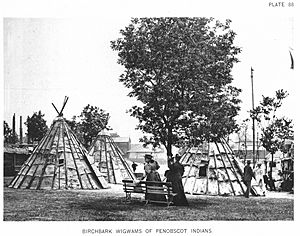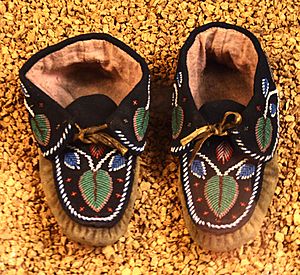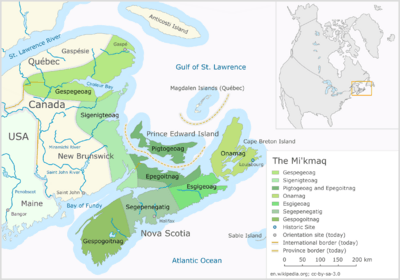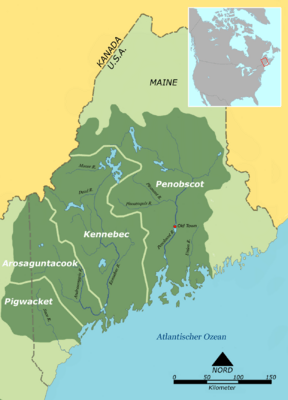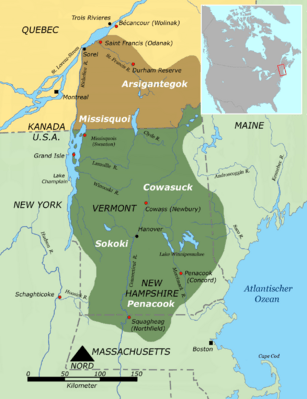Penobscot facts for kids
| Pαnawάhpskewi | |
|---|---|
| Total population | |
| 2,278 enrolled members | |
| Regions with significant populations | |
| 2,278 (0.2%) | |
| Languages | |
| Abenaki, English | |
| Religion | |
| Wabanaki mythology, Christianity | |
| Related ethnic groups | |
| Abenaki, Maliseet, Mi'kmaq, Passamaquoddy | |
The Penobscot (in their own language, Pαnawάhpskewi) are an Indigenous people from North America. They live in the Northeastern Woodlands region. They are officially recognized as a tribe in Maine, United States. They are also recognized as a First Nations group in Atlantic Canada and Quebec.
The Penobscot Nation is the main group of Penobscot people in the United States. They are part of the Wabanaki Confederacy. This group also includes the Abenaki, Passamaquoddy, Maliseet, and Miꞌkmaq nations. All these groups historically spoke Algonquian languages. Today, the Penobscot Nation's main home is the Penobscot Indian Island Reservation. This reservation is located in Maine along the Penobscot River.
Contents
- Understanding the Penobscot Name
- Penobscot Government and Leadership
- Penobscot History and Culture
- Penobscot Language and Communication
- Traditional Penobscot Homes
- Penobscot Arts and Crafts
- Penobscot Spirituality and Beliefs
- Penobscot Connection to Nature
- Gambling and Economic Activities
- Notable Penobscot People
- Maps
- See also
Understanding the Penobscot Name
The Penobscot people call themselves Pαnawάhpskewi. This name means "the people of where the white rocks extend out." It described their homeland along the Penobscot River. This area was between what is now Old Town and Verona Island, Maine. When Europeans arrived, they misheard the name. They started calling the people "Penobscot," which is the name used today.
Penobscot Government and Leadership
The Penobscot Nation's main office is in Penobscot Indian Island Reservation, Maine. The current tribal chief is Kirk Francis. Bill Thompson serves as the vice-chief. The Penobscot Nation can send a representative to the Maine House of Representatives. This representative does not vote on laws.
In 2005, the Penobscot Nation worked with the government of Venezuela. They received help in the form of heating oil. Tribal chief Kirk Francis traveled to New York City to meet with Venezuelan officials.
Penobscot History and Culture
Life Before European Contact
Not much is known about the Penobscot people before Europeans arrived. It is believed that Indigenous peoples have lived in Maine for at least 11,000 years. The Penobscot had a hunting and gathering way of life. Men hunted animals like beaver, moose, bears, and caribou. They also caught fish, seafood, and birds. Women gathered berries, nuts, and roots.
The Penobscot did some farming. However, they did not farm as much as groups in southern New England. This was because the climate was colder. Food was usually plentiful for most of the year. The Penobscot and other Wabanaki groups moved with the seasons. They followed the movements of game and fish.
European Arrival and Changes
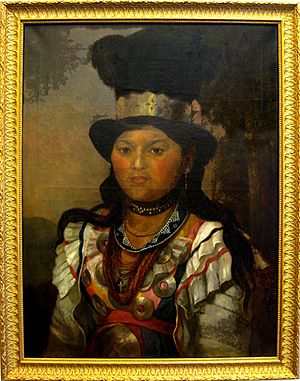
During the 1500s, the Penobscot met Europeans through the fur trade. They traded animal furs for European goods. These goods included metal axes, guns, and cooking pots. Hunting for furs caused the number of wild animals to decrease.
Europeans also brought new diseases to the Americas. The Penobscot people had no protection against these illnesses. Diseases like measles and smallpox caused many deaths. Their population also fell due to settlers moving onto their land. Settlers built dams on the Penobscot River, which blocked fish. They also cut down forests, reducing big game animals. These changes greatly affected the Penobscot way of life.
In the early 1600s, Europeans began living year-round in Wabanaki territory. At this time, there were likely about 10,000 Penobscot people. By the early 1800s, this number dropped to fewer than 500. As more Europeans settled, conflicts grew. These conflicts were about different cultures, ideas of land ownership, and competition for resources.
During the French and Indian War in the mid-1700s, the Penobscot sided with the French. The French were seen as less of a threat to their land. After the French lost the Battle of Quebec in 1759, the Penobscot were in a weaker position.
During the American Revolution, the Penobscot supported the Patriots. They played a key role in battles near the border of British Canada and the United States. However, the new American government did not fully recognize their help. Anglo-American settlers continued to take Penobscot lands.
In the centuries that followed, the Penobscot tried to make treaties to keep their land. But they had little power to enforce these agreements. Americans continued to move onto their lands. From about 1800, the Penobscot lived on reservations. Their main home became Indian Island, an island in the Penobscot River.
Protecting Penobscot Land Rights
In 1790, the U.S. government passed the Nonintercourse Act. This law said that tribal lands could only be transferred with approval from the United States Congress. Between 1794 and 1833, the Penobscot and Passamaquoddy tribes gave up most of their lands to Massachusetts. This happened through treaties that were never approved by the U.S. Senate. These treaties were illegal under the U.S. Constitution. The tribes were left with only the Penobscot Indian Island Reservation.
In the 1970s, Native American tribes began to assert their rights more strongly. The Penobscot Nation sued the state of Maine for land claims. They asked for land, money, and self-governance. This was because the state had broken the Nonintercourse Act. The disputed land covered 60% of Maine. About 35,000 people, mostly non-tribal members, lived in this area.
The Penobscot and the state reached an agreement in 1980. This was called the Maine Indian Claims Settlement Act (MICSA). The settlement gave the Penobscot $81.5 million. They could use this money to buy more tribal land. The act also created the Maine Indian Tribal-State Commission. This group helps resolve disagreements between the state and the Penobscot or Passamaquoddy tribes.
The Penobscot Nation is a federally recognized sovereign nation. This means it has a direct relationship with the U.S. federal government. The Nation has disagreed with Maine's claim that it can control tribal hunting and fishing. In 2012, the Nation sued the state. They argued that the 1980 MICSA agreement gave them authority over hunting and fishing in the Penobscot River's "Main Stem" and on their reservation.
The U.S. Department of Justice joined the lawsuit to support the tribe. Five members of the Congressional Native American Caucus also supported the Penobscot. This case is very important for Native American law and sovereignty. It is compared to fishing rights cases in the Pacific Northwest in the 1970s. Those cases confirmed tribal rights to fish and hunt in their traditional territories.
Penobscot Language and Communication
Historically, Penobscot people spoke a dialect of Eastern Abenaki. This is an Algonquian language. It is very similar to the languages of other Wabanaki Confederacy members. Today, there are no fluent speakers of Penobscot. The last known speaker, Madeline Tower Shay, passed away in the 1990s.
A dictionary of the language was created by Frank Siebert. The elementary school and the Boys and Girls Club on Indian Island are working to bring the language back. They are teaching it to children. The written Penobscot language uses a modified Roman alphabet. It includes special characters for sounds not found in the Roman alphabet.
Traditional Penobscot Homes
The Penobscot Indians did not live in tepees. They lived in small houses made of birchbark called wigwams. The inside walls and ceilings of these wigwams were sometimes decorated. Penobscot artists would paint murals on them.
Penobscot Arts and Crafts
Making Baskets
The Penobscot traditionally made baskets from natural materials. These included sweet grass, brown ash, and birch bark. These materials grow in wetlands throughout Maine. However, some of these plants are now at risk. This is due to habitat loss and the emerald ash borer, an insect that harms ash trees.
Baskets were first made for everyday use. After meeting Europeans, the Penobscot began making "fancy baskets" to trade. Basket-making is a skill traditionally passed down through women in families. Many tribal members are now learning old techniques and creating new designs.
Birchbark Canoes
The birch bark canoe was once a very important way to travel for all nations of the Wabanaki Confederacy. Each nation made canoes with a unique shape. These canoes were made from a single piece of bark from a white birch tree. If done carefully, the large piece of bark could be removed without harming the tree.
Penobscot Spirituality and Beliefs
The Penobscot people have a deep connection to the land and its resources in Maine. This connection is shown in their stories and their respect for nature. Their spiritual beliefs guide their efforts to protect the land and natural resources. The landscapes of Maine are very important to the Penobscot's survival and beliefs. Their namesake river is seen as a living being and is very special to them.
Their beliefs begin with their origin story. In this story, Klose-kur-beh (Gluskbe) is the main character. Klose-kur-beh gave the Penobscot "spiritual knowledge" and "practical knowledge," like how to build a canoe. He also taught them important rules for living. Klose-kur-beh taught humans and animals skills needed to survive in the Northeast. He also punished those who did not follow his rules.
French missionaries converted many Penobscot people to Christianity. Today, some Penobscot members practice traditional spirituality. Others on Indian Island are Catholic or Protestant.
Penobscot Connection to Nature
Through their stories, the Penobscot learned that plants and animals were their helpers and friends. They believed that people should also act as family and friends to the living world around them. These stories teach about a universe where everything interacts and depends on each other. This is different from the European view, which often saw land as something to own and use for profit. This difference highlights the importance of protecting Penobscot culture and land.
Gambling and Economic Activities
In 1973, the Penobscot Nation opened Penobscot High Stakes Bingo on Indian Island. This was one of the first commercial gambling operations on a reservation in the United States. Bingo games are held one weekend every six weeks. The Penobscot tribe has worked to get state laws passed. These laws allow them to add slot machines to their bingo hall, which they have now been granted.
Notable Penobscot People
- Maulian Dana: The first Penobscot tribal ambassador. She is the daughter of former chief Barry Dana.
- Donna M. Loring: An author, broadcaster, and tribal representative for the Penobscot.
- Madockawando: A sachem (chief) who led his people against English settlers during King William's War.
- Sherri Mitchell: An attorney, author, teacher, and activist.
- Wayne Mitchell: A politician elected by the Penobscot Tribe of Maine. He served as a non-voting tribal representative to the Maine House of Representatives.
- Old John Neptune: A medicine man and tribal leader mentioned by Henry David Thoreau.
- Joseph Nicolar: A Tribal Representative to the Maine Legislature and author of The Life and Traditions of the Red Man (1893).
- Joseph Orono: A sachem who encouraged his tribe to side with the Americans against the English.
- Lucy Nicolar Poolaw: An entertainer known as "Princess Watahwaso," a businesswoman, and an activist.
- Darren Ranco: An anthropologist at the University of Maine.
- Rebecca Sockbeson: A Wabanaki scholar, activist, and associate professor at the University of Alberta.
- Theresa Secord: An artist, basketmaker, geologist, and activist. She is related to Horace Nelson.
- Charles Norman Shay: A Penobscot Tribal Elder and a decorated veteran of World War II and the Korean War.
- Andrew Sockalexis: A marathon runner who competed in the 1912 Stockholm Olympics. He was inducted into the Maine Running Hall of Fame in 1989.
- Louis Sockalexis: The first Native American to play in major league baseball for the Cleveland Guardians.
- Molly Spotted Elk: (Mary Alice "Molly Dellis" Nelson Archambaud), 1903–1977. She was an internationally known dancer and starred in the film The Silent Enemy.
- ssipsis: A poet, social worker, visual artist, writer, editor, and storyteller. Her work focused on and was inspired by the advancement of Indigenous peoples.
- Kiayaun Williams-Clark: An American actor known for roles in Saints of Newark, Power, and Guild.
- Carla Knapp: National Vice President of Native Services for the Boys & Girls Clubs of America.
Maps
Maps showing the approximate locations of areas occupied by members of the Wabanaki Confederacy (from north to south):
- Maps of the Wabanaki Confederacy areas
-
Eastern Abenaki (Penobscot, Kennebec, Arosaguntacook, Pigwacket/Pequawket)
-
Western Abenaki (Arsigantegok, Missisquoi, Cowasuck, Sokoki, Pennacook
See also
 In Spanish: Penobscot para niños
In Spanish: Penobscot para niños


